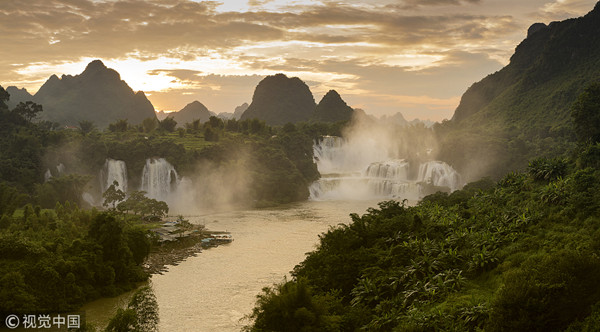Chongzuo

Detian Waterfall, the second largest transnational waterfall in the world and the largest in Asia [Photo/VCG]
Chongzuo is located on the southwestern border of the motherland. It borders Nanning to the northeast, Qinzhou to the north, Baise to the northwest, Fangchenggang to the southeast, and Vietnam to the west. Chongzuo is at the intersection of the South China Economic Circle, Southwest Economic Circle and the ASEAN Economic Circle. It is also on the main channel of the "Nanning – Lang Son – Hanoi – Haiphong – Quang Ninh" economic corridor. All these have endowed Chongzuo with unique geographical advantages.
The city's border line is 533 kilometers in length, accounting for 53.78 percent of the total length of the land border between Guangxi and Vietnam. It has the longest border line among prefecture-level cities in Guangxi. Five Level One ports, two Level Two ports and 14 border exchange points constitute a multi-level open cooperation platform along the border. Guangxi Pingxiang Comprehensive Bonded Zone is the first comprehensive bonded zone in China that truly realizes "adhesive development, interconnection and seamless integration" along its land border. It is also a comprehensive bonded zone with the most complete functions, the smoothest process and the highest degree of informatization in China. It is the largest and most convenient port operation area along the China-ASEAN land border line.
Chongzuo is in close proximity to ASEAN and boasts convenient transportation. The municipal government is located in Jiangzhou district of Chongzuo and it is 90 kilometers away from Nanning Wuxu International Airport, 120 kilometers away from Nanning and 230 kilometers away from Hanoi. It is connected by the Hunan–Guangxi railway and Hanoi-Beijing-Moscow international railway.
Chongzuo also has rich mineral resources including coal, manganese, iron, tungsten, bismuth, copper, lead, zinc, gold, silver, antimony, mercury, aluminum, sandstone, clay and silica. The city has 60 mining areas (mine sections, mine fields) that have completed exploration work and identified resource reserves, and 72 mineral deposits that are being surveyed. Among them, five minerals such as manganese, bentonite, iron, bauxite and limestone have obvious advantages and conditions for large-scale mining.
Chongzuo has a wide variety of animal and plant resources. There are 696 species of terrestrial vertebrae in the city. Among them, 14 species include white-headed langurs, black langurs and clouded leopards under national level I protection, and 89 species include macaques, pangolins, crown spots and rhinoceros hornbillos under national level II protection. There are three national nature reserves including Nonggang Protected Area, Chongzuo White-Headed Langurs Protection Area and Encheng Nature Reserve. There are also four regional protection areas including Zuojiang Lamprotula Mansuyi Nature Reserve, Guangxi Xialei Water Source Forest Protection Area, West Daming Mountain Water Source Forest Protection Area and Guangxi Qinglong Mountain Reserve.
Chongzuo has a long history and rich tourism resources. The main tourist attractions in the city include Chongzuo Guilong Leaning Tower, one of the eight largest leaning towers in the world, Stone Forest of Chongzuo and the world's rare animal white-headed langur conservation area-Nongguan Ecological Park. In Chongzuo, the Nonggang National Nature Reserve has international terrestrial biodiversity significance. The Ningming Huashan Cliff Murals represents the Zhuang's ancestral culture. Detian Waterfall is the second largest transnational waterfall in the world and the largest in Asia. Friendship Pass in Chongzuo is one of China's nine famous passes. In addition, there are ancient border and cultural landscapes including Liancheng Fortress, Ancient Battery and the Eighth Red Army Memorial Hall in the city.














